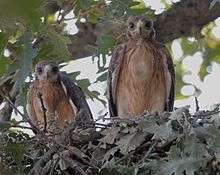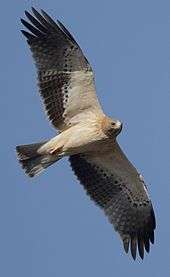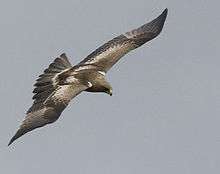Booted eagle
- "Aquila minuta" redirects here. If based on Brehm (1831), it refers to this bird. The fossil bird described under the same name by Milne-Edwards (1871) is preliminarily known as "Hieraaetus" edwardsi but might belong in Aquila.
| Booted eagle | |
|---|---|
 | |
| A dark morph wintering in India | |
| Scientific classification | |
| Kingdom: | Animalia |
| Phylum: | Chordata |
| Class: | Aves |
| Order: | Accipitriformes |
| Family: | Accipitridae |
| Genus: | Hieraaetus |
| Species: | H. pennatus |
| Binomial name | |
| Hieraaetus pennatus (Gmelin, 1788) | |
| Synonyms | |
| |
The booted eagle (Hieraaetus pennatus, also classified as Aquila pennata) is a medium-sized mostly migratory bird of prey with a wide distribution in the Palearctic and southern Asia, wintering in the tropics of Africa and Asia, with a small, disjunct breeding population in south-western Africa. Like all eagles, it belongs to the family Accipitridae.
Description
The booted is a small eagle, comparable to the common buzzard in size though more eagle-like in shape. Males grow to about 510–770 g (1.12–1.70 lb) in weight, with females about 840–1,025 g (1.852–2.260 lb) with a length of 40 cm and a wingspan of 11–132 cm. There are two relatively distinct plumage forms. Pale birds are mainly light grey with a darker head and flight feathers. The other form has mid-brown plumage with dark grey flight feathers.[2]

The call is a shrill kli-kli-kli.[2]

Distribution and habitat
It breeds in southern Europe, North Africa and across Asia, and also in western South Africa and Namibia.[3] The northern populations are migratory, wintering in Sub-Saharan Africa and South Asia, while the small southern African populations is sedentary. This is a species of wooded, often hilly countryside with some open areas, it breeds in rocky, broken terrain but migrants will use almost any type of habitat other than dense forest.[3]
Habits
This eagle lays 1–2 eggs in a nest built from sticks and line with green leaves in a tree,on a crag crag or it takes over the disused nest of another large bird such as a black kite or grey heron. The female incubates the egg for around 45 days and is fed by the male, after hatching she guards the nest and the young while the male provides all the food. The chick fledges after 70–75 days.[3]

It hunts small mammals, reptiles and birds up to 5 times its own weight.[3]
Taxonomy
Based on recent genetic research some authors reclassified this species to the genus Aquila, along with some[4] or all[5] other Hieraaetus species. As it is the type species of Hieraaetus, should any of the hawk-eagles have been retained in a distinct genus then a new name for that group would have been necessary. However, DNA research has shown it forms a monophyletic clade with Ayres's hawk eagle, Wahlberg's eagle, little eagle and the pygmy eagle and this clade is often treated as forming the genus Hieraeetus[6] and most reference lists currently use H. pennata.[7][8]
Along with the little eagle, this bird is one of the closest living relatives of the extinct Haast's eagle of New Zealand.[9]
Although some authors name a number of subspecies most now treat it as a monotypic species.[10]
References
- ↑ BirdLife International (2013). "Hieraaetus pennatus". IUCN Red List of Threatened Species. Version 2013.2. International Union for Conservation of Nature. Retrieved 26 November 2013.
- 1 2 Kemp, Alan; Kemp, Meg (1998). SASOL Birds of Prey of Africa and its Islands. New Holland. pp. 104–105. ISBN 1 85974 100 2.
- 1 2 3 4 "Aquila pennatus (Booted eagle)". Biodiversity Explorer. Iziko Musems of Southern Africa. Retrieved 2016-11-02.
- ↑ Collinson, Martin (June 2006). "Splitting headaches? Recent taxonomic changes affecting the British and Western Palaearctic lists". British Birds. 99: 306–323.
- ↑ According to Avibase, The Clements Checklist first reassigned the Hieraaetus spp. to Aquila in the 2001 revisions to the 5th edition. However, in the 2009 revisions to the 6th edition, four species (including booted eagle) were moved back to Hieraaetus.
- Clements, James F. (June 2007). The Clements Checklist of Birds of the World (6th ed.). Ithaca, New York: Cornell University Press. pp. 47–48.
- The Clements Checklist team (23 December 2009). "Updates & Corrections – December 2009". The Cornell Lab of Ornithology. Retrieved 21 June 2014.
Pages 47-48, Wahlberg’s Eagle Aquila wahlbergi, Booted Eagle Aquila pennata, Little Eagle Aquila morphnoides, Ayres’s Hawk-Eagle Aquila ayresii. All of these eagles belong in the genus Hieraaetus
- ↑ "Booted Eagle - Aquila pennata". The Eagle Directory. Retrieved 2016-11-03.
- ↑ Gill, Frank; Donsker, David, eds. (2014). "New World vultures, Secretarybird, kites, hawks & eagles". IOC World Bird List, version 4.2. International Ornithologists' Union. doi:10.14344/IOC.ML.4.2. Retrieved 21 June 2014.
- ↑ "Hieraaetus Kaup, 1844". Integrated Taxonomic Information System (ITIS) [online database]. Retrieved 22 June 2014.
- ↑ Bunce, M.; Szulkin, M.; Lerner, H.R.L.; Barnes, I.; Shapiro, B.; Cooper, A.; Holdaway, R.N. (2005). "Ancient DNA provides new insights into the evolutionary history of New Zealand's extinct giant eagle". PLoS Biol. 3 (1): e9. doi:10.1371/journal.pbio.0030009. PMC 539324
 . PMID 15660162.
. PMID 15660162. - ↑ "Booted Eagle Hieraaetus pennatus (Gmelin, JF, 1788)". Avibase. Denis Lepage. Retrieved 2016-11-03.
- Lerner, H.R.L.; Mindell, D.P. (2005). "Phylogeny of eagles, Old World vultures, and other Accipitridae based on nuclear and mitochondrial DNA" (PDF). Molecular Phylogenetics and Evolution. 37: 327–346. doi:10.1016/j.ympev.2005.04.010. PMID 15925523.
Further reading
- Clark, William S. (1–8 November 1986). The rufous morph of the Booted Eagle. International Bird Identification: Proceeedings of the 4th International Identification Meeting. Eilat: International Birdwatching Centre Eilat. pp. 21–24.
External links
| Wikimedia Commons has media related to Hieraaetus pennatus. |
| Wikispecies has information related to: Hieraaetus pennatus |
- Booted Eagle species text in The Atlas of Southern African Birds
- Booted eagle Photos at Oiseaux.net
- Ageing and sexing (PDF; 4.2 MB) by Javier Blasco-Zumeta & Gerd-Michael Heinze
- Booted Eagle from Nagpur, India, photo by Anuj Kale
- Booted Eagle on the Global Raptor Information Network
- BirdLife species factsheet for Hieraaetus pennatus
- "Booted eagle media". Internet Bird Collection.
- Booted eagle photo gallery at VIREO (Drexel University)
- Interactive range map of Hieraaetus pennatus at IUCN Red List maps
- Audio recordings of Booted eagle on Xeno-canto.
